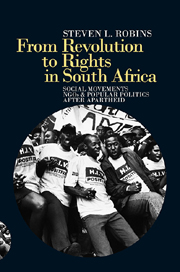 From Revolution to Rights in South Africa
From Revolution to Rights in South Africa Book contents
- Frontmatter
- Contents
- Foreword & Acknowledgements
- Abbreviations
- Zapiro cartoons
- 1 Introduction
- 2 Activist Mediations of ‘Rights’ & Indigeneous Identity
- 3 Citizens & ‘Bushmen’
- 4 ‘Civil Society’ & Popular Politics in the Postcolony
- 5 AIDS, Science & the Making of a Social Movement
- 6 Rights Passages from ‘Near Death’ to ‘New Life’
- 7 Sexual Rights & Sexual Cultures
- 8 Conclusion
- Bibliography
- Index
1 - Introduction
From Revolution to Rights
Published online by Cambridge University Press: 05 April 2013
- Frontmatter
- Contents
- Foreword & Acknowledgements
- Abbreviations
- Zapiro cartoons
- 1 Introduction
- 2 Activist Mediations of ‘Rights’ & Indigeneous Identity
- 3 Citizens & ‘Bushmen’
- 4 ‘Civil Society’ & Popular Politics in the Postcolony
- 5 AIDS, Science & the Making of a Social Movement
- 6 Rights Passages from ‘Near Death’ to ‘New Life’
- 7 Sexual Rights & Sexual Cultures
- 8 Conclusion
- Bibliography
- Index
Summary
We did not say our struggle against apartheid was a civil rights struggle. We said it was a liberation struggle. There is actually a difference … A liberation struggle includes socioeconomic issues, it includes power relations. It includes structures of society, etc. Whereas civil rights is a legalistic notion. For instance, you would agree, surely, if we change the law on the rights of women with respect to property that would not actually emancipate women … So, when people were talking today, in the [G8 Parliamentary Conference] meeting about women's rights, it was quite a limited, legalistic formulation. (Professor Ben Turok, an African National Congress Member of Parliament, New Agenda, Issue 19, 2005:14–15). Discourses of rights and responsibilities conveniently cast the powers of economy and state as relatively benign at a historical moment when both seem nearly unassailable anyway.
(Brown 1995: xiii)Introduction
During South Africa's first decade of democracy, cultural rights claims took varied and fascinating forms. For example, shortly after the arrival of democracy in 1994, delegations of middle-class white Afrikaners converged on UN-sponsored indigenous rights meetings in Geneva and elsewhere claiming to be indigenous peoples just like the Inuit, the San, Aborigines, Maoris, and so on. At roughly the same time, similarly minded Afrikaners established the all-white Volkstaat (Homeland) of Oranje in an attempt to live out their ideals of ethnic self-determination in a post-apartheid constitutional democracy that protected language and cultural rights.
- Type
- Chapter
- Information
- From Revolution to Rights in South AfricaSocial Movements, NGOs and Popular Politics After Apartheid, pp. 1 - 28Publisher: Boydell & BrewerPrint publication year: 2008
